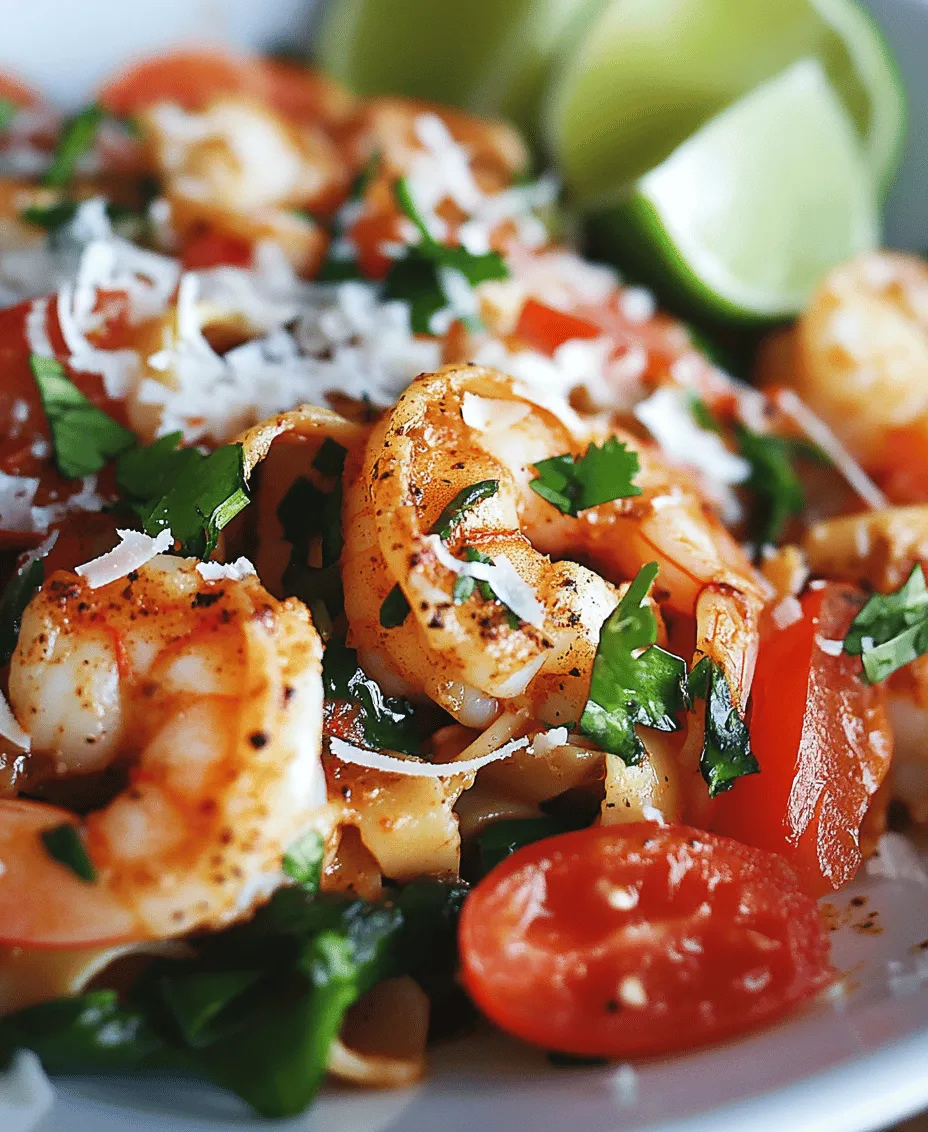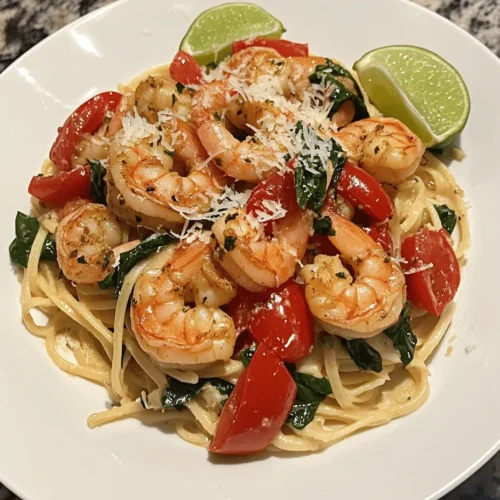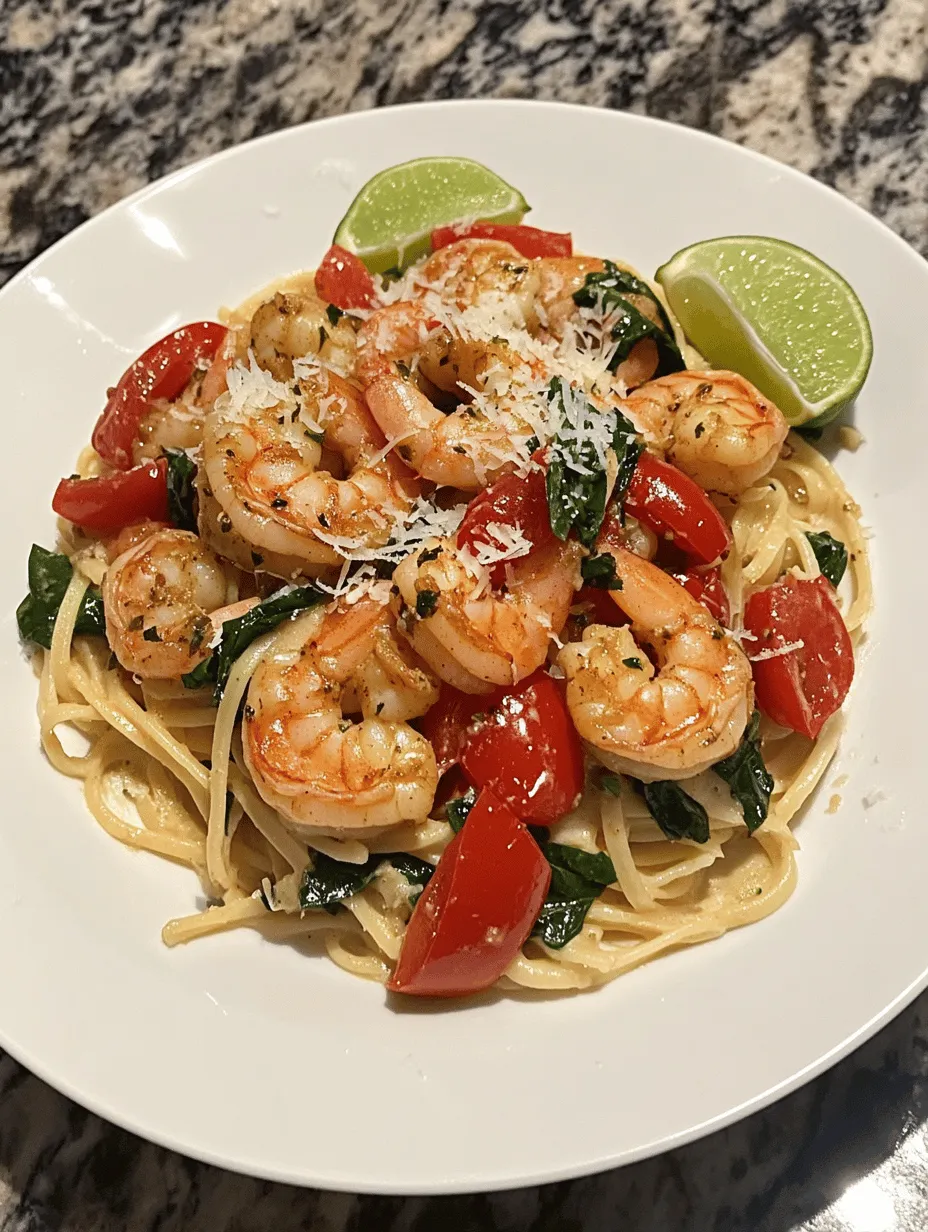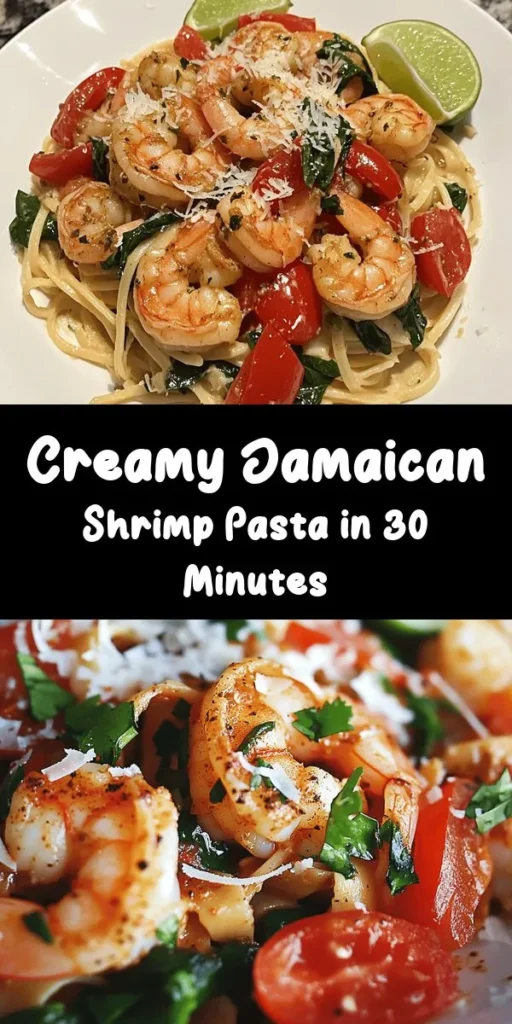The culinary world of Jamaican cuisine is a vibrant tapestry of flavors that transports your taste buds to a sun-soaked paradise. Known for its bold spices, fresh ingredients, and tropical essence, Jamaican cooking offers a unique dining experience that blends tradition with innovation. One such delightful creation is Jamaican Shrimp Pasta, a dish that marries the richness of creamy coconut milk with the zest of jerk seasoning. This dish promises to be both comforting and exotic, inviting you to savor each bite while dreaming of the Caribbean coast.
Imagine a plate of perfectly cooked pasta enveloped in a luscious, creamy sauce, punctuated by succulent shrimp and vibrant vegetables. The combination of flavors creates a symphony that dances on your palate, making this dish an unforgettable experience. Whether you’re hosting a dinner party or simply treating yourself to a cozy night in, Jamaican Shrimp Pasta is sure to impress.
Understanding Jamaican Cuisine
To truly appreciate Jamaican Shrimp Pasta, it’s essential to understand the roots and characteristics of Jamaican cuisine. The island’s culinary traditions are a reflection of its rich history, influenced by various cultures, including African, European, and Asian. This melting pot of flavors is evident in the use of fresh, locally sourced ingredients and bold spices that define the Jamaican palate.
At the heart of Jamaican cooking is jerk seasoning, a spice blend that embodies the island’s spirit. Traditionally used for marinating meats, jerk seasoning consists of ingredients like Scotch bonnet peppers, allspice, thyme, garlic, and ginger. This unique combination creates a fiery yet aromatic flavor profile that elevates any dish it graces. In Jamaican Shrimp Pasta, jerk seasoning serves as a key ingredient, infusing the dish with its characteristic heat and depth.
Jamaican cuisine is all about celebrating fresh produce and vibrant flavors, and this pasta dish is no exception. Each ingredient plays a crucial role in creating a harmonious balance of taste and texture, making it a true representation of Jamaican culinary artistry.
Ingredients Breakdown
Pasta Choices
When it comes to pasta for your Jamaican Shrimp Pasta, linguine or fettuccine are the top contenders. These long, flat noodles are ideal for holding onto the creamy sauce, ensuring that each bite is flavorful and satisfying. Linguine, with its slightly thinner profile, offers a delicate texture, while fettuccine provides a heartier chew. Both options complement the dish beautifully, allowing the sauce to cling to the noodles while creating a delightful mouthfeel.
Shrimp Selection
The star of the show in Jamaican Shrimp Pasta is undoubtedly the shrimp. For the best results, opt for fresh, large shrimp. When purchasing shrimp, look for those that are firm to the touch and have a pleasant, briny smell. If fresh shrimp isn’t available, frozen shrimp can be a suitable alternative—just ensure they are properly thawed before use.
Preparing shrimp effectively is essential to achieving the perfect texture. Begin by peeling and deveining the shrimp, then rinse them under cold water and pat dry. This step not only ensures cleanliness but also allows the shrimp to absorb the flavors of the marinade and sauce more effectively.
Vegetables
A medley of colorful vegetables takes this dish from ordinary to extraordinary. The combination of garlic, onion, red bell pepper, cherry tomatoes, and spinach adds depth, flavor, and nutritional value.
– Garlic and Onion: These aromatic ingredients lay the foundation for the sauce, providing a savory base that enhances the overall flavor profile.
– Red Bell Pepper: With its sweet crunch, red bell pepper adds a pop of color and a hint of sweetness that balances the dish’s spiciness.
– Cherry Tomatoes: These juicy gems burst with flavor and acidity, offering a refreshing contrast to the creamy sauce.
– Spinach: Not only does spinach contribute vibrant green color, but it also adds a nutritional boost, making the dish more wholesome.
Coconut Milk
Coconut milk is a game-changer in Jamaican Shrimp Pasta. Known for its creamy texture and subtle sweetness, it serves as the perfect base for the sauce. The richness of coconut milk balances the heat from the jerk seasoning, creating a harmonious blend of flavors. Moreover, its tropical essence brings an authentic Jamaican flair to the dish, reminiscent of the island’s lush landscapes.
Jerk Seasoning
As mentioned earlier, jerk seasoning is the heartbeat of Jamaican cuisine and an essential component of this pasta recipe. The unique blend of spices not only infuses the shrimp with a bold flavor but also elevates the entire dish. The combination of heat from the Scotch bonnet peppers and warmth from allspice creates a tantalizing experience that lingers on the palate. When combined with the creamy coconut milk, jerk seasoning transforms the dish into a culinary adventure that is both comforting and exciting.
Parmesan and Garnishes
To finish off the dish, a sprinkle of grated Parmesan cheese adds a savory richness that enhances the overall flavor. The cheese melts into the sauce, creating a velvety texture that makes every bite irresistible. For a fresh finishing touch, garnish the pasta with chopped cilantro and serve lime wedges on the side. The bright acidity of lime juice elevates the flavors further, providing a refreshing contrast to the creamy sauce.
Step-by-Step Cooking Instructions
Now that you have an understanding of the ingredients, it’s time to dive into the cooking process. Follow these detailed steps to create your Jamaican Shrimp Pasta:
Cooking the Pasta
1. Boil Water: Start by bringing a large pot of salted water to a boil. The salt enhances the pasta’s flavor as it cooks.
2. Cook the Pasta: Add your choice of linguine or fettuccine to the boiling water and cook according to package instructions until al dente. This usually takes about 8-10 minutes, depending on the type of pasta. Stir occasionally to prevent sticking.
3. Reserve Pasta Water: Just before draining the pasta, reserve about 1 cup of the pasta cooking water. This starchy water will help to adjust the sauce’s consistency later on.
4. Drain and Set Aside: Drain the pasta in a colander, but do not rinse it. Rinsing removes the starch that helps the sauce adhere to the noodles. Set the pasta aside while you prepare the sauce.
By following these steps, you’re setting the foundation for a flavorful and satisfying meal that will surely win over anyone lucky enough to sit at your table. Stay tuned for the next part of the recipe, where we will explore the preparation of the creamy sauce and the assembly of this delightful dish.

Cooking Pasta to Perfection: The Al Dente Technique
When preparing Jamaican Shrimp Pasta, achieving the perfect texture for your pasta is critical. Cooking pasta al dente, which means “to the tooth” in Italian, ensures that the pasta retains a slight firmness when bitten. This texture plays a significant role in the overall dish, as it provides a delightful contrast to the creamy sauce and tender shrimp. Undercooking the pasta slightly allows it to absorb the flavors of the sauce while still maintaining its structure, ensuring that each bite is satisfying.
To achieve this, follow the package instructions for cooking times closely, but start tasting the pasta a minute or two before the recommended time. It should be firm yet tender, giving a slight resistance when bitten. Once ready, drain the pasta and toss it with a bit of olive oil to prevent sticking while you prepare the other components of the dish.
Sautéing Vegetables: Unlocking Flavor Through Caramelization
Sautéing is a fundamental cooking technique that enhances the flavor of vegetables through a process called caramelization. When you sauté onions, bell peppers, and garlic, the natural sugars in these ingredients brown and develop a rich, complex flavor profile. For this Jamaican Shrimp Pasta, begin by heating a tablespoon of olive oil in a large skillet over medium heat. Add finely chopped onions and cook until they become translucent.
Next, incorporate diced bell peppers and minced garlic into the skillet. Sauté the mixture for several minutes until the vegetables are tender and slightly golden. This not only enriches the dish with flavor but also adds a vibrant color that is visually appealing. Caramelized vegetables serve as a flavorful foundation that complements the shrimp and creamy sauce, creating a harmonious blend in each bite.
Cooking the Shrimp: The Art of Tenderness
When it comes to cooking shrimp, timing is paramount. Overcooked shrimp can become rubbery and tough, detracting from the overall enjoyment of your dish. For your Jamaican Shrimp Pasta, use fresh or thawed shrimp, ensuring they are peeled and deveined.
In the same skillet used for the vegetables, increase the heat to medium-high and add the shrimp in a single layer. Cook for 2-3 minutes on each side until they turn pink and opaque. The shrimp should curl slightly but remain tender. As soon as they are cooked through, remove them from the skillet and set them aside; this will prevent them from cooking further in the residual heat. This careful approach will yield perfectly cooked shrimp that enhance the dish’s texture and flavor.
Creating the Creamy Sauce: A Coconut Milk Delight
The sauce is the heart of the Jamaican Shrimp Pasta, and coconut milk is the star ingredient that brings a creamy, tropical essence to the dish. To create the sauce, return the sautéed vegetables to the skillet and add a can of coconut milk. Stir well to combine, allowing the mixture to simmer gently.
To enhance the sauce further, add a splash of lime juice for acidity and brightness, as well as seasonings such as salt, pepper, and a pinch of cayenne pepper for a subtle kick. If you prefer a thicker sauce, let it simmer for a few more minutes until it reduces to your desired consistency. Remember to taste and adjust the seasoning as needed, ensuring the sauce complements the shrimp and pasta perfectly.
Combining Ingredients: Harmonizing Flavors
Once your pasta is cooked and drained, it’s time to bring everything together. Add the pasta directly to the skillet with the creamy coconut sauce, along with the sautéed shrimp. Use tongs or a large spoon to gently toss the pasta with the sauce, ensuring that every strand is coated evenly. This step is crucial for flavor distribution; the creamy sauce should cling to the pasta while enveloping the succulent shrimp and vegetables.
If the sauce appears too thick, you can add a splash of pasta cooking water to loosen it up. This starchy water not only helps in achieving the perfect consistency but also enhances the sauce’s flavor, creating a velvety finish that clings beautifully to the pasta.
Serving Suggestions: Making It Visually Appealing
When it comes to serving your Jamaican Shrimp Pasta, presentation is key. Start by plating a generous portion of the pasta in a shallow bowl. The vibrant colors of the shrimp and vegetables contrasting against the creamy sauce will make the dish visually inviting.
To elevate the presentation, garnish each serving with freshly chopped cilantro and lime wedges. The cilantro adds a pop of green and a fresh aroma, while the lime provides a bright finishing touch that encourages diners to squeeze over their pasta for an extra burst of flavor.
Plating Techniques
Consider using a large serving dish if you’re presenting the pasta for a gathering. Create a mound in the center and let the ingredients spill slightly over the sides for an enticing look. Drizzle a bit of extra coconut milk or a light olive oil over the top for sheen and appeal, making sure to place the garnishes strategically to draw the eye.
Pairing Recommendations
To enhance the dining experience, consider serving your Jamaican Shrimp Pasta with a side of garlic bread or a fresh garden salad. The garlic bread complements the creamy sauce, while a salad provides a refreshing contrast. As for beverages, a chilled glass of white wine, such as Sauvignon Blanc or a light beer, pairs wonderfully with the dish, balancing the richness of the coconut milk and shrimp.
Nutritional Analysis: Balanced and Wholesome
Jamaican Shrimp Pasta is not only a treat for the palate but also a balanced meal option. Shrimp is an excellent source of high-quality protein, providing essential amino acids and nutrients while being low in fat. The coconut milk contributes healthy fats, particularly medium-chain triglycerides (MCTs), which are beneficial for energy.
The addition of vegetables adds vitamins, minerals, and fiber to the dish, supporting overall health. Carbohydrates from the pasta provide the necessary energy for an active lifestyle. Overall, this dish can fit well into a balanced diet, offering an array of nutrients while indulging in the rich flavors of Caribbean cuisine.
Cultural Significance: A Fusion of Flavors
The cultural significance of shrimp pasta in Jamaica reflects the island’s rich culinary traditions and the fusion of diverse influences. Seafood has always been a staple of Jamaican cuisine, with shrimp being particularly popular due to its abundance in surrounding waters. The incorporation of pasta demonstrates the influence of Italian cooking, showcasing how global cuisines can merge to create something unique and delightful.
This Jamaican Shrimp Pasta is a celebration of flavors, merging the tropical essence of coconut and lime with the hearty satisfaction of pasta. It embodies the creativity found in global cooking, where boundaries between culinary traditions blur, resulting in dishes that tell a story.
Conclusion: A Taste of the Caribbean at Home
Jamaican Shrimp Pasta is more than just a meal; it is an experience that transports you to the vibrant shores of the Caribbean. With its creamy coconut sauce, tender shrimp, and perfectly cooked pasta, this dish encapsulates the essence of bold flavors and culinary creativity.
By following the steps outlined in this guide, you can easily recreate this quick and flavorful dish in your kitchen, bringing a taste of the Caribbean to your dining table. Embrace the joy of cooking with fresh ingredients, vibrant spices, and your own personal touch. Share this delightful meal with family and friends, and celebrate the communal experience of enjoying good food together.



